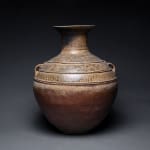Warring States Glazed Terracotta Hu, 475 BCE - 221 CE
Glazed Terracotta
height 45.1 cm
height 17 3/4 in
height 17 3/4 in
H.809
Further images
Whereas before, war was characterized as a civilized contest between aristocratic armies, during the Warring States Period (475-221 B.C.), war evolved into the chaotic conflict we know it as today....
Whereas before, war was characterized as a civilized contest between aristocratic armies, during the Warring States Period (475-221 B.C.), war evolved into the chaotic conflict we know it as today. Kings and princes were replaced on the battlefield by infantries lead by military generals. Peasants were recruited to serve on the front lines. Warfare intensified, especially in terms of the duration of campaigns. New arms and armor were invented, including the halberd and crossbow. Chariots rode alongside archers outfitted in iron helmets and body armor. Defensive walls were erected in order to repel invaders. However, despite the turmoil of the times, the arts continued to thrive. Bronze casting was revolutionized by the introduction of the lost-wax technique, while the alterations of kiln structures enabled new firing techniques that resulted in fully developed glazes.
Although the Warring States Period was marked by almost constant upheaval, it also represents a golden age of Chinese culture and thought. Needless to say, the arts continued to flourish as this exquisite terracotta reveals. Such as vessel would have been used for storing, transporting, and serving fine wines. The sharply flaring neck has been decorated with two bands featuring an incised pattern of undulating lines that give the impression of the waves of the ocean. Meanwhile, the shoulder and upper half of the body have been adorned with an intricate incised abstracted foliate patterns and ribbed rings that slightly protrude from the vessel’s surface. Two small handles emerge from either side and are most likely decorative, imitating functional handles seen on bronze examples. Although this vessel would have functioned as a wine container in life, it was found discovered buried in a tomb. A symbol for the bountiful pleasures of life, for drinking and feasting, this would have represented the joys to be experienced in the afterlife and the feasts and celebrations yet to come. Today, this vessel is not only a gorgeous work of art, treasured for its history and rarity; but also a stunning reminder of the richness and luxury of the Ancient China, both in this world and the next.
Although the Warring States Period was marked by almost constant upheaval, it also represents a golden age of Chinese culture and thought. Needless to say, the arts continued to flourish as this exquisite terracotta reveals. Such as vessel would have been used for storing, transporting, and serving fine wines. The sharply flaring neck has been decorated with two bands featuring an incised pattern of undulating lines that give the impression of the waves of the ocean. Meanwhile, the shoulder and upper half of the body have been adorned with an intricate incised abstracted foliate patterns and ribbed rings that slightly protrude from the vessel’s surface. Two small handles emerge from either side and are most likely decorative, imitating functional handles seen on bronze examples. Although this vessel would have functioned as a wine container in life, it was found discovered buried in a tomb. A symbol for the bountiful pleasures of life, for drinking and feasting, this would have represented the joys to be experienced in the afterlife and the feasts and celebrations yet to come. Today, this vessel is not only a gorgeous work of art, treasured for its history and rarity; but also a stunning reminder of the richness and luxury of the Ancient China, both in this world and the next.





